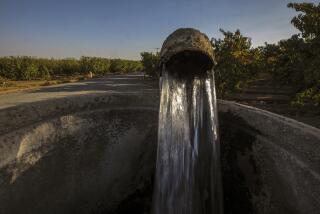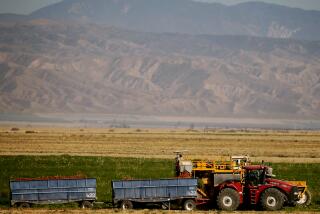Tapping the Valley’s groundwater
There is a history of alarmism over the prospect of tapping the groundwater of the San Fernando Valley for use by Los Angeles residents. “Toilet to tap” was the hysterical slogan used to denounce — and defeat — plans for reclaiming treated water and using it to quench this region’s perpetual thirst. In that iteration, which flared in the late 1990s, water from a local sewage treatment plant was to be treated, pumped to the Hansen Dam area, allowed to settle through gravel and soil, mixed with other water and recycled into the water supply. The result would have been water just as clean as any other tap water, but it fell victim to the politics of San Fernando Valley secession, as cynical and cowardly politicians stirred public anxiety about the water’s safety and then let the project die.
So it is with some apprehension that the city’s Department of Water and Power embarks on a project to draw water from the San Fernando Groundwater Basin. This time, the issue is not reclaiming water so much as avoiding — and compensating for — the effects of World War II-era pollution. In the years of thriving defense industry production, solvents and other chemicals found their way into the water supply, creating genuine health risks to those exposed to them. Some of those chemicals are proven carcinogens and present other dangers as well.
But not all of that water is polluted, and some that is contaminated could be cleaned. As a result, and in recognition of this region’s important commitment to lessen its dependency on imported water, the DWP is launching a plan to test water at 26 sites in the Valley and identify safe sources that could be further purified. If successful, that could allow the agency to draw enough water from the basin to supply more than 175,000 homes every year.
There will no doubt be anxiety associated with this project. Officials insist they will proceed with caution and will share information with city officials and community representatives as they roll out the monitoring wells and collect data. That’s appropriate and welcome. The city leadership has another obligation: to recognize that Los Angeles’ future requires a delicate combination of conservation and development of local water supplies to reduce reliance on water from the Eastern Sierra, the Sacramento-San Joaquin River Delta and the Colorado River, all of which are subject to droughts and competing claims.
From the beginning, Los Angeles has depended on water brought from afar. Every reasonable effort to develop local supplies should be applauded and pursued, with care and caution.
More to Read
A cure for the common opinion
Get thought-provoking perspectives with our weekly newsletter.
You may occasionally receive promotional content from the Los Angeles Times.










